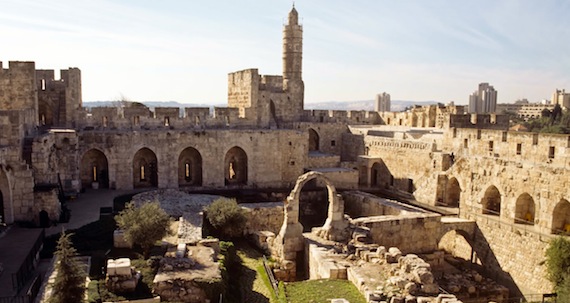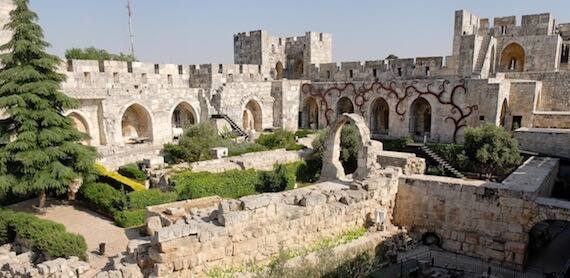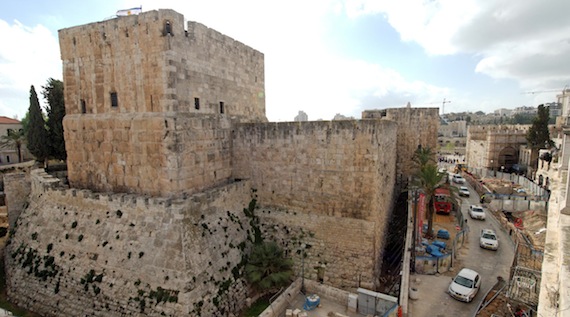Whenever someone asks how to spend a day in Jerusalem, I try to steer the person away from shopping malls and toward the Tower of David Citadel—Jerusalem’s museum of the city’s history.
The museum does what no book can. In just a few hours’ time, one can catch a glimpse of Jerusalem’s history as well as observe archaeology from the city’s various periods.

(Photo: Courtyard of David Citadel, Jerusalem. Courtesy of the Pictorial Library of Bible Lands)
Ironically, the museum that does so much to remove the confusion about Jerusalem’s history is named in error.
The Tower of David Citadel in Jerusalem has nothing to do with David.
The David Citadel—Jerusalem’s Posh Palace It Was
The Tower of David Citadel dominates the western side of the Old City.
- The location served as the palace of Herod the Great, a structure so lavish that Josephus wrote, “[It] exceeds all my ability to describe it” (Wars 5.176).
- Herod’s sprawling palace extended from the area near the Jaffa Gate through most of the Armenian Quarter.
In AD 6, shortly after Herod the Great’s death, the Romans began to govern Judea. Not surprisingly, Roman procurators chose Herod’s posh palace as their Jerusalem residence. Normally, they resided in Herod’s beautiful seaside palace in Caesarea, the Roman capital of Judea.
Where Pontius Pilate Judged Jesus
Because Pontius Pilate stayed at the Jerusalem palace, or Praetorium, he likely held the trial there in which he condemned Jesus.
The popular identification of the Antonia Fortress as Pilate’s Praetorium finds its basis in tradition, not history.
- Josephus indicates that the Roman governor not only resided in Herod’s palace, but set up his judgment seat before it (Wars, 2.14).
- Philo flat-out says Pilate stayed in the palace (Leg. in Caium, 38, 39).
Even though history points to the David Citadel as Jerusalem’s Praetorium, tradition often overshadows truth.
[slideshow id=44]
(All pics courtesy of the Pictorial Library of Bible Lands)
on my upcoming trip to Israel.
See the details, browse the tour itinerary, and
download a FREE brochure! After your journey to Israel,
you will never be the same!
The David Citadel—The Tower of David and Other Misnomers
A number of regrettable misnomers stemmed from the fifth century as Byzantine Christians misidentified the Western Hill as biblical “Mount Zion”—a name the hill still bears today.
- This misidentification also caused the Byzantines to mistake Herod’s palace for King David’s palace, and the name “Tower of David” stuck.
- In the 1800s, the designation moved to the 17th-century minaret in the Citadel’s southwest corner. I always get a laugh from the historical and geographical contradictions of this minaret: Turkish rulers built the “Tower of David” on a hill that had nothing to do with the Hebrew monarch.
- Furthermore, the alleged “Tomb of David” also rests on the same wrong hill, as does the gate called Bab Nabi Daud, “Gate of the Prophet David”—the Zion Gate.
Tower of David Citadel—Jerusalem’s History Made Easy
The David Citadel museum offers an unparalleled history of Jerusalem and a microcosm of Israel’s history.
Housed in various sections of the restored ruins, the museum traces the major periods of Jerusalem’s past.
- From the Canaanite period, to the First- and Second-Temple periods, as well as the Roman, Byzantine, Muslim, Crusader, Ayyubid, Mamluk, and Ottoman periods, the museum uses high-tech displays to trace Jerusalem’s history and archaeology from its beginnings all the way through the British Mandate and the founding of the State of Israel.
- The magnificent exhibitions—in Hebrew, Aramaic, and English—are entertaining as well as educational.
- More than forty volunteers guide visitors through the exhibits. An audio guide is also available.
- The Tower of David Citadel also hosts a number of temporary exhibits, lectures, and educational programs. There’s even a nighttime sound and light show.
The museum really helps untie the knots of Jerusalem’s tangled history. King Herod would be proud.

(Photo: Hasmonean ruins in the David Citadel, Jerusalem. Courtesy of the Pictorial Library of Bible Lands)
Tower of David Citadel—Jerusalem’s Archaeology in Samples
A stroll through the outside grounds offers a taste of Jerusalem’s rich archaeological past.
- Stretching through the courtyard lies a section of Hasmonean wall from the 2nd-century BC—part of the wall Josephus called “the first wall” (the first of three) that surrounded Jerusalem during the Second Temple period.
- A round Muslim tower dates from the 7th– and 8th-century AD.
- Herodian stones with their signature relief (just like at the Western Wall) are found here and there.
Other archaeological finds abound—all worth noticing.
The Tower of David is Really Whose?
Herod’s original Citadel had three towers that he named after his wife Miriam, his friend Hippicus, and his brother Phasael.
- The Phasael Tower still stands, with additions from the Mamluk period, and offers the best panoramic view of the Old City from its western side.
- Couples often get engaged on the tower. In fact, one travel guide designates the museum as one of the most romantic places in the world. (I’m not sure I get that.)

(Photo: Phasael Tower, David Citadel, Jerusalem, courtesy of the Pictorial Library of Bible Lands)
My wife and I stood atop the Phasael Tower one afternoon and enjoyed reading the events of the Passion Week as recorded in the gospels.
- Most of the events’ locations we could find in the contours of the city that stretched below us in broad panorama.
- It was especially meaningful to know that Pilate tried Jesus in the Citadel itself before condemning Him to crucifixion at the nearby site of the present Church of the Holy Sepulcher.
A Preview is Better than a Review
Most of the time, a visit to the Tower of David Citadel Museum in Jerusalem occurs on a visitor’s last day—a good review. But I think it should happen on day one—for a good preview.
Either way, the overview of Jerusalem’s history offers valuable hooks to hang information on.
Tell me what you think: What part of the David Citadel in Jerusalem is most interesting to you? To leave a comment, just click here.
David Citadel Jerusalem on the Map:
